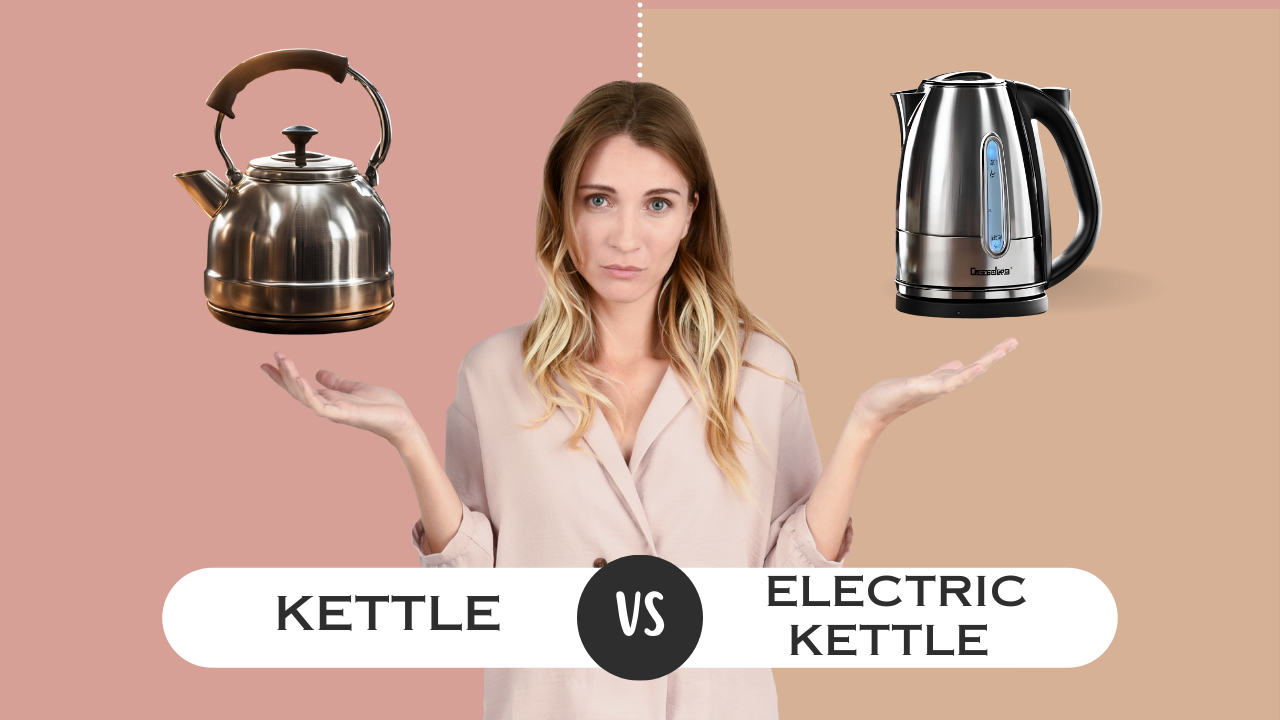Ever wondered why some people use their electric kettles while others are using traditional ones? It’s not just about boiling water—it’s about convenience, speed, and style!
In this post, we’ll explore the key differences between a regular kettle and an electric kettle, so you can make the right choice for your kitchen.
Whether you’re a tea lover or just looking to save time, understanding these differences can help you upgrade your daily routine.
Table of Contents
What is a Kettle?

A kettle is a simple, everyday kitchen device used to boil water. Typically made of metal, it has a spout for easy pouring and a handle to lift it without burning your hands. You’ve probably seen one sitting on your stovetop or hanging above the fire, ready to make your favorite cup of tea or coffee.
How it Works:
To use a kettle, you simply fill it with water and place it on a stove or heating element. As the stove heats the metal body of the kettle, the water inside heats up and eventually starts boiling. When the water reaches boiling point, the steam often makes the kettle whistle, letting you know it’s ready to use.
Types of Kettles:
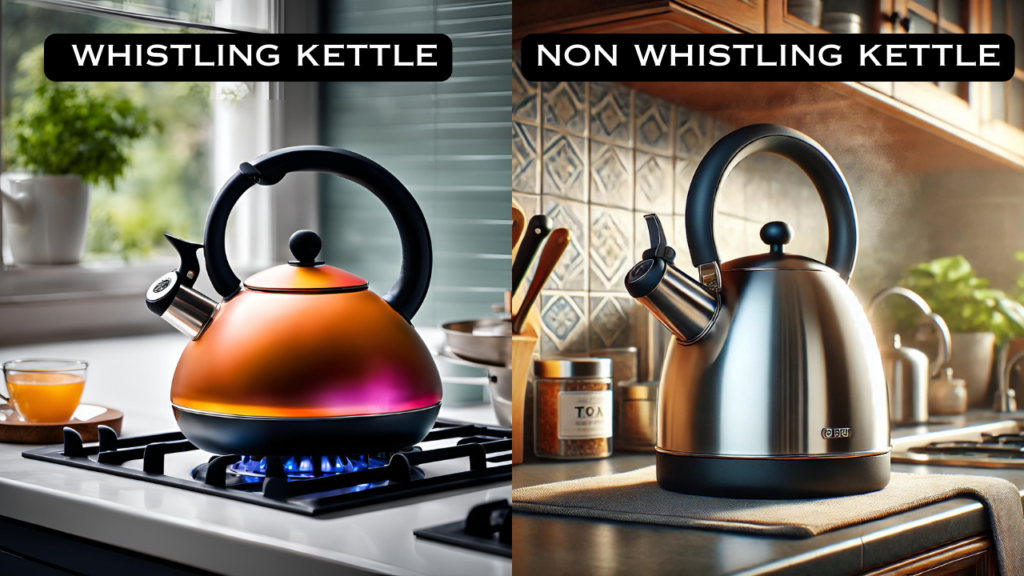
- Whistling Kettles: These are the traditional stovetop kettles that make a whistling sound once the water has boiled.
- Non-whistling Kettles: These don’t whistle but rely on the heat left in the kettle to indicate when the water is ready.
Common Materials:
- Stainless Steel: Durable, rust-resistant, and long-lasting.
- Copper: A great conductor of heat, but requires more maintenance.
- Aluminum: Lightweight and easy to handle, though not as durable as others.
- Glass: Aesthetic and easy to clean but less durable than metal kettles.
What is an Electric Kettle?

An electric kettle is a fast, convenient appliance designed to boil water quickly. Unlike traditional kettles, it uses an electric heating element inside to heat water, making the process much faster. Once the water reaches the boiling point, it automatically shuts off, saving you time and effort.
How it Works:
To use an electric kettle, simply plug it into an electrical outlet and turn it on. The heating element inside the kettle starts to heat the water. As soon as the water boils, a thermostat or auto shut-off feature turns off the kettle, so you don’t have to worry about it over-boiling. Some electric kettles even have extra features like quick-boil settings, variable temperature control, and safety shut-off if the water runs out.
Types of Electric Kettles:
- Basic Electric Kettles: These just boil water and shut off automatically once it’s ready.
- Variable Temperature Kettles: Let you set a specific temperature, perfect for different types of tea or coffee.
- Cordless Electric Kettles: These kettles can be removed from their base, making pouring and cleaning much easier.
Common Features:
- Cordless: The kettle can be detached from its power base for easy pouring.
- Temperature Control: Perfect for brewing different drinks.
- Auto Shut-Off: Turns off automatically once the water boils, keeping things safe.
Electric kettles are all about making boiling water quicker and easier for you!
↘️↘️↘️
You can also check other kettle related article👉👉👉 Do kettles use a lot of electricity ?
Key Differences Between a Kettle and an Electric Kettle
When it comes to boiling water, both kettles and electric kettles get the job done, but they work in different ways.
| Feature | Kettle | Electric Kettle |
| Heating Method | Relies on external heat sources (stove or fire) | Uses an internal heating element powered by electricity |
| Speed of Boiling | Takes 8–10 minutes or more | Boils water in 2–3 minutes |
| Power Consumption | No electricity required; uses stove energy | Uses electricity but is energy-efficiency |
| Portability & Convenience | Can only be used with a stove or heat source | Can be used anywhere with an electrical outlet; often portable |
| Temperature Control | No temperature control | Many models offer variable temperature control for different drinks |
| Auto Shut-Off | Does not have an automatic shut-off feature | Automatically shuts off once the water boils |
| Whistle Feature | Some have a whistle to signal boiling | No whistle; depends on the automatic shut-off |
| Ease of Cleaning | May be harder to clean, especially if the inside gets rusted | Generally easy to clean with detachable bases and simple designs |
| Safety Features | No specific safety features | Features like auto shut-off and dry boil protection for safety |
| Material Options | Stainless steel, copper, aluminum, glass | Mostly stainless steel or plastic with glass variants |
Pros and Cons of an Electric Kettle
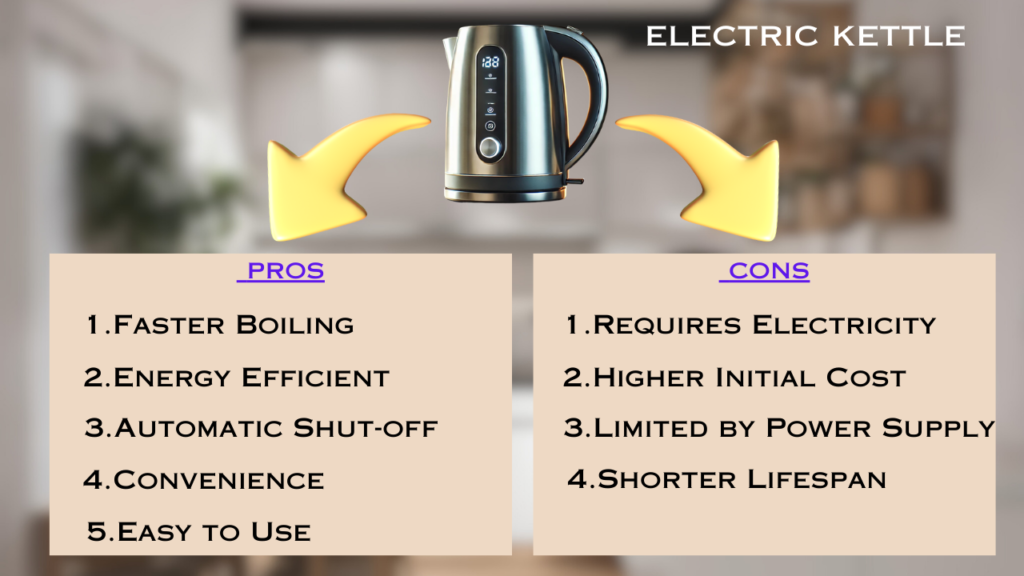
Pros:
- Faster Boiling: Electric kettles heat water much faster than traditional kettles. They can boil water up to three times quicker, saving you time, especially when you’re in a rush.
- Energy Efficient: Unlike stovetop kettles, which heat up the whole metal body, electric kettles only heat the water inside. This means they use less energy, which is good for your electricity bill.
- Automatic Shut-off: One of the best safety features! When the water is boiled, the kettle automatically turns off. This helps prevent the risk of the kettle boiling dry, which could damage it.
- Convenience: Many electric kettles come with cool features like temperature control and digital displays. Some can even keep the water warm for a longer time, making them super convenient.
- Easy to Use: Electric kettles are usually lightweight and simple to operate. With just a button to press, you can have boiling water in minutes.
Cons:
- Requires Electricity: An electric kettle won’t work without power. So, if the electricity is out, you’ll have to rely on a stovetop kettle.
- Higher Initial Cost: Electric kettles are generally more expensive than regular stovetop kettles, so you’ll spend more upfront.
- Limited by Power Supply: Since it needs an electrical outlet, you can’t use it just anywhere. It’s not as portable as a stovetop kettle.
- Shorter Lifespan: With more parts and electronics, electric kettles might wear out quicker compared to a simple stovetop kettle.
So, while an electric kettle is fast and convenient, it does come with some trade-offs!
Pros and Cons of a Kettle
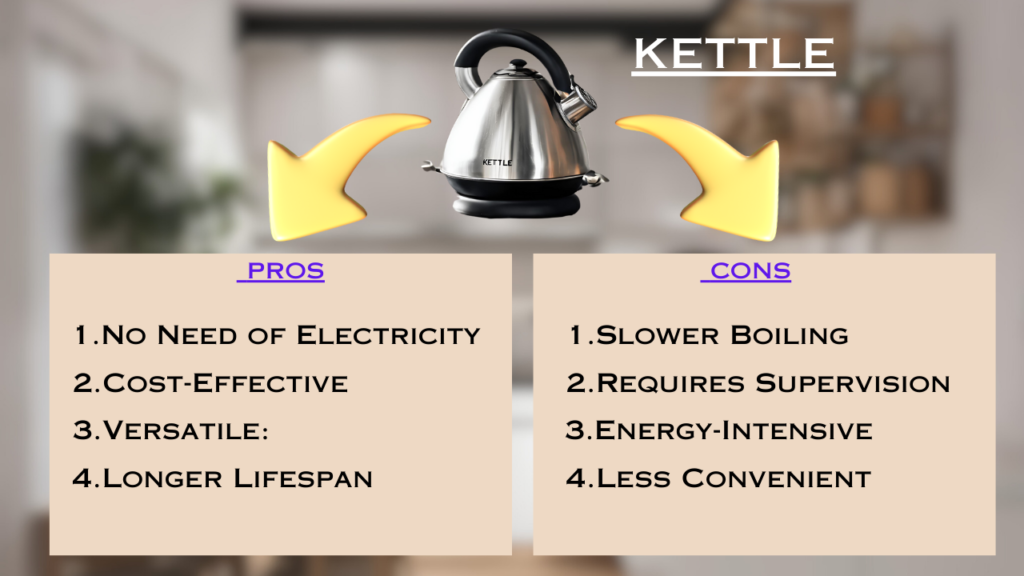
Pros:
- Does Not Need Electricity: A traditional kettle doesn’t rely on power, making it great for places with unreliable electricity or when you’re camping outdoors. It works on any stove, whether gas, electric, or even over an open flame.
- Cost-Effective: Regular kettles are usually cheaper than electric kettles. If you don’t need fancy features, a traditional kettle can save you some money.
- Versatile: You can use a kettle anywhere there’s a heat source. This makes it perfect for outdoor adventures, like camping, where you might not have access to electricity.
- Longer Lifespan: Since traditional kettles don’t have electronics or moving parts, they tend to last longer with proper care.
Cons:
- Slower Boiling: A kettle takes longer to boil water than an electric kettle because the heat has to travel through the stove and the kettle itself.
- Requires Supervision: You need to watch the kettle closely while it boils to make sure it doesn’t boil over or burn.
- Energy-Intensive: A traditional kettle uses more energy since the entire kettle body gets heated up, unlike an electric kettle that heats only the water.
- Less Convenient: Without features like automatic shut-off or temperature control, you have to keep an eye on the kettle until it’s done boiling.
In short, a kettle is great for its simplicity and cost-effectiveness, but it requires more attention and takes longer to boil water.
↘️↘️↘️↘️
You can also check this blog 👉👉👉Do kettles use induction ?Advantages of Using an Electric Kettle Over a Manual Kettle
Speed: One of the biggest advantages of an electric kettle is how fast it boils water. It heats water directly, which is much quicker than a manual kettle on a stovetop. This means you save time, especially when you’re in a hurry.
Convenience: Electric kettles are super convenient because you don’t have to keep an eye on them. Once you set the water to boil, it automatically shuts off when it’s ready. Some even have a keep-warm setting, so you don’t need to reheat the water if you’re not ready to use it right away. This allows you to multitask and do other things while your water boils.
Energy Efficiency: Electric kettles are designed to focus on heating just the water, so they use less energy than a stovetop kettle. Stovetop kettles heat the entire body of the kettle, which wastes more energy. In contrast, electric kettles are more efficient and can help lower your electricity bill.
Temperature Control: Many electric kettles offer adjustable temperature settings, allowing you to set the water to the perfect heat for different drinks. Whether it’s tea, coffee, or instant noodles, you can get the exact temperature you need, which a traditional kettle can’t do.
Safety Features: Electric kettles come with added safety features like boil-dry protection and automatic shut-off. These features help prevent accidents, making them safer to use in the kitchen.
Best Kettles to Buy
If you’re thinking of upgrading your kettle, here are some of the best options out there. Whether you prefer an electric kettle for quick boiling or a stovetop kettle for a more traditional feel, these picks are sure to meet your needs.
Philips HD9306/06 Electric Kettle
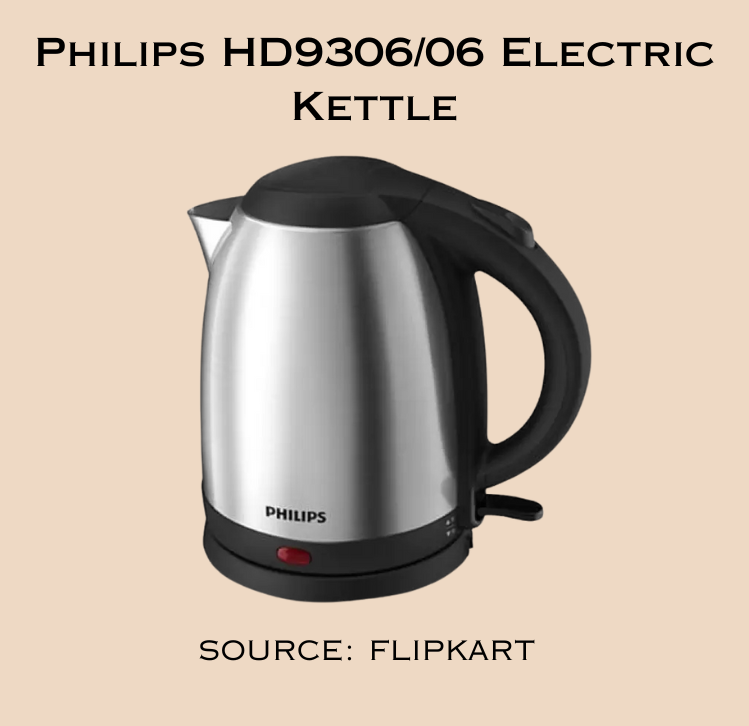
Why It’s Great: The Philips HD9306/06 electric kettle is well-known for its speed and energy efficiency. With a powerful 1800-watt element, it boils water quickly and has features like automatic shut-off and boil-dry protection, ensuring safety and convenience.
Pros:
- Quick Boiling: This kettle can heat water up in no time.
- Safety Features: It has automatic shut-off and boil-dry protection, making it safe to use.
- Easy to Clean: Its sleek design makes it easy to wipe down and clean.
Cons:
- Slightly Heavier: It’s a bit heavier than some other electric kettles, so it may not be the most portable option.
WANT TO BUY AT LOW PRICE — CLICK HERE
Bajaj Majesty KTX 15 1.7 Litre Electric Kettle
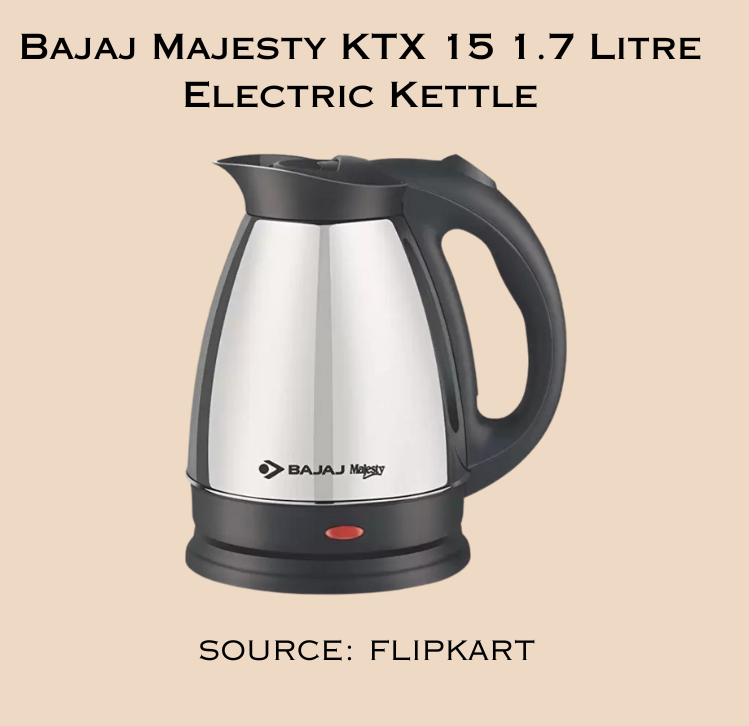
Why It’s Great: If you need a larger kettle, the Bajaj Majesty KTX 15 is a great choice. This kettle comes with a large 1.7-liter capacity and features like auto shut-off and dry-boil protection, making it both stylish and functional.
Pros:
- Large Capacity: Can hold up to 1.7 liters, perfect for bigger families or groups.
- Durable Stainless Steel: It has a sturdy and sleek stainless steel body that’s easy to clean.
- Easy to Handle: The ergonomic handle makes pouring easier.
Cons:
- Takes Up More Space: Its larger size may take up more space on your countertop compared to smaller models.
WANT TO BUY AT LOW PRICE — CLICK HERE
Kenstar Estella 1.8 Litre 1500 Watts Stovetop Kettle
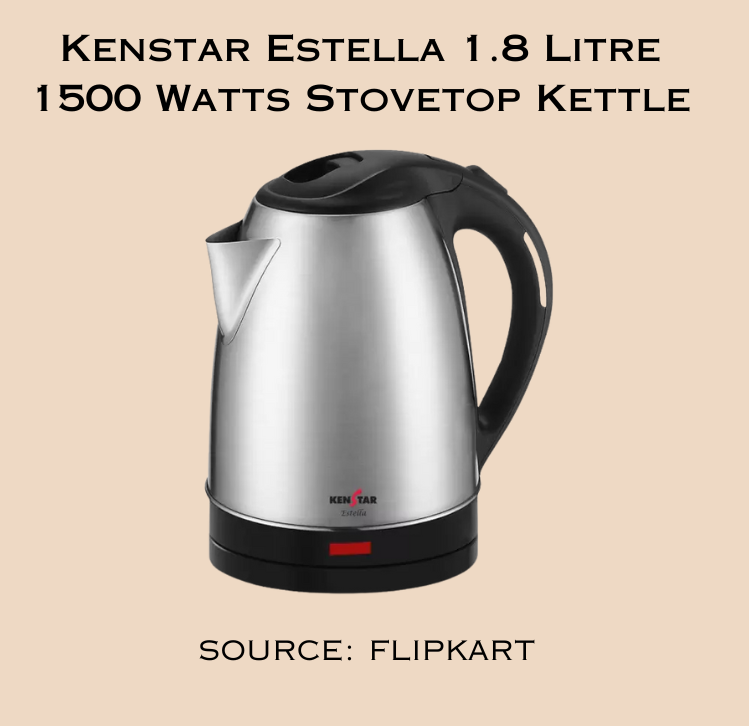
Why It’s Great: For those who prefer a traditional stovetop kettle, the Kenstar Estella is a fantastic option. With a 1.8-liter capacity, it’s perfect for heating large amounts of water. Plus, the 1500-watt power ensures quick boiling.
Pros:
- Large Capacity: At 1.8 liters, it’s perfect for big families or when you need more water for tea or coffee.
- Quick Boiling: The 1500-watt power ensures fast heating, even on stovetops.
- Durable Design: Built to last with high-quality materials.
Cons:
- Requires Stovetop: You’ll need to use it on a stove, so it’s less convenient than electric kettles.
WANT TO BUY AT LOW PRICE — CLICK HERE

